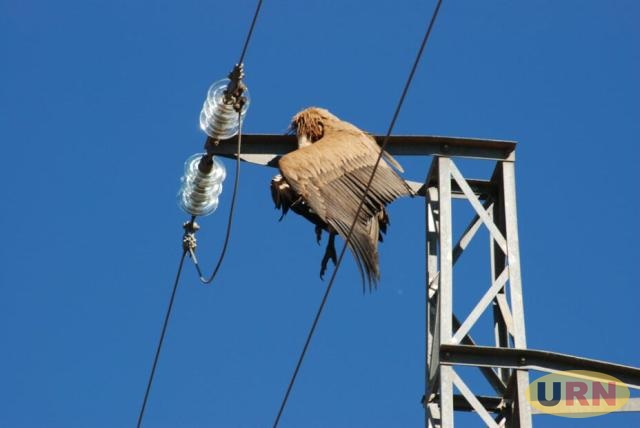
Kampala, Uganda | THE INDEPENDENT | Parties to the Convention on Migratory Species (CMS) are alarmed by the negative impacts of large energy infrastructural projects on migratory species.
The third day of the Conference taking place in Samarkand, Uzbekistan deliberated reports by the Energy Task Force (ETF).
The ETF brings together governments, multilateral environmental agreements, investors, the private sector, and non-governmental organizations to avoid and minimize the negative impacts of energy developments on migratory species.
It focuses on promoting the sustainable deployment or retrofitting of renewable energy installations such as wind turbines and power lines, sharing best practices in energy infrastructure deployment, offering recommendations for addressing specific issues and conducting research to fill knowledge gaps.
There is evidence that the construction of renewable energy infrastructure, such as wind turbines, has altered the landscape in ways that migratory species have not been exposed to in the past.
Conservation Scientists have evidence that infrastructure developments fragment and destroy habitats and create barriers to the movements of species, thereby isolating populations and preventing access to essential resources such as food and water, causing die-offs and reduced fitness.
They further found that infrastructure also causes direct injuries and mortality through collisions as well as disturbance and pollution.
The delegates in Samarkand are particularly concerned that those barriers lead to the loss of ecological connectivity leading to genetic isolation. Genetic isolation leaves smaller populations which are more vulnerable and prone to local extinction.
Linear infrastructure such as fences, railways, roads, pipelines, and canals create significant barriers to the movements of migratory mammals.
Estimates suggest that by 2030, over US$90 trillion will be required for infrastructure development to achieve the Sustainable Development Goals and to reduce climate risks in line with the Paris Agreement.
Egypt, a member of the Energy Task Force is among the countries whose delegates called for action to save migratory species especially birds from the risk of collision and electrocution from power lines. Delegates from different countries supported the idea of establishing a global atlas about animal migration so that countries can track and report on their experiences.
“This will greatly contribute to enhancing and improving the understanding of migration patterns,” said a delegate from Bahrain. India is among the countries that equally support the mapping of migratory species.
Parties also discussed the need to develop powerful spatial planning tools and sensitivity maps that can help identify the best areas to build renewable energy infrastructure without jeopardizing migratory species.
The European Union and its member state requested parties to the convention to take into account ecological restoration and ecological sensitivity when planning ne liner infrastructure to embrace conservation.
Some countries like the United Arab Emirates (UAE) were reluctant to endorse a call urging parties to make public information on infrastructure plans and assessments.
“The UA believes in a more flexible approach that respects national policies and circumstances. Therefore we propose an alternative text that encourages transparency and cooperation in a manner that is feasible and in line with national regulations “said a delegate from UAE.
Birds of Prey in the Spotlight
A recent report published in the journal Nature Ecology and Evolution found that Africa’s birds of prey are facing an extinction crisis.
According to the report by an international team of researchers, African savanna raptors such as the Rüppell’s Vulture, the Steppe Eagle, and the iconic Secretary bird are showing evidence of widespread and significant population declines, as well as a growing dependence on protected areas across the African continent.
Birds of prey are a group of birds known for their prowess as predators. There are over 560 species of birds of prey, including hawks, owls, eagles, vultures, and falcons, which can be found on every continent on Earth except Antarctica. They hunt small animals, like rodents, rabbits, fish, lizards, and other birds, aided by their acute vision and incredible speed.
Their sharp talons and hooked beaks are perfect for grabbing prey from the air, the water, or the ground and carrying it away. Birds of prey are apex predators and play an important ecological role in maintaining the environmental health of their natural habitats.
Their hunting habits remove old, sick, and weak animals from prey populations and help keep their numbers under control. Birds of prey are also indicator species, which means their health and population in an area reflect the health of the habitat overall. For example, birds of prey numbers will be strong if there are lots of rodents to eat, and if there are lots of rodents, it means plant foods, like seeds and grains, are also abundant. Each of the approximately 560 raptor species has its own conservation status on the IUCN red list.
Of these, 18% are considered vulnerable, endangered, or critically endangered, and 13% are listed as near threatened. Unfortunately, even among the 142 species categorized as least concern, 38% have declining population trends, suggesting they, too, could become threatened in the foreseeable future.
Uganda is one of the member states and parties to the Convention on Migratory Species. URN has seen a report detailing Uganda’s efforts to save migratory species.
The successes being reported to the conference included the enactment of the new Wildlife Act 2019, which has put deterrent penalties eg illegal trade and trafficking of endangered species attracts 5.5Mn USD or life imprisonment, and the new environment Act 2019, which provides for strict measures against pollution.
Uganda also reported that the eviction of encroachments on critical habitat has led to the increased availability of range for migratory species.
The commencement of government-supported monitoring of water birds, and the operationalization of the Greater Virunga Transboundary Treaty between Uganda, DRC, and Rwanda for the conservation of gorillas and their habitats were also mentioned.
Uganda said awareness campaigns have resulted in increased involvement of the public in the protection of the migratory species on public land.
******
URN
 The Independent Uganda: You get the Truth we Pay the Price
The Independent Uganda: You get the Truth we Pay the Price


